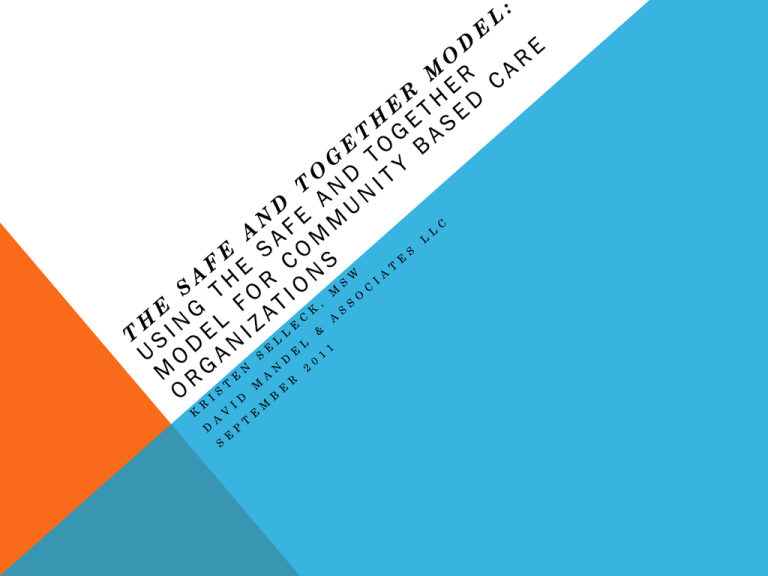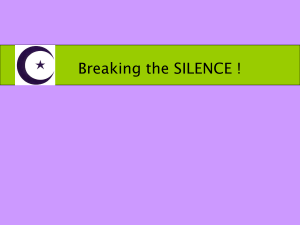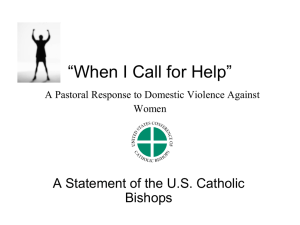
MAJOR RECENT, CURRENT, UPCOMING PROJECTS
Statewide Service Administration (CT DCF): DV Consultants
Subject Matter Expert Training (FL DCF)
Gainesville
Jacksonville
Lake City
CLS Training (FL DCF)
Safe and Together Advocate Training (FCADV)
All Child Welfare Supervisors (LA)
Safe and Together Supervisor Training (KC MO)
Alternative Response Pilot (OH): Train the Trainers
INTERSECTION OF DOMESTIC VIOLENCE AND
OTHER CHILD WELFARE CONCERNS
Substance abuse
•A US study reports that 60% of women accessing drug or alcohol services (n = 360) reported current or past
domestic abuse.
•A Yale trauma study showed that abused women are 15 times more likely to use alcohol and 9 times more
likely to use drugs than non- abused women.
•Findings from a review of the British Crime Surveys revealed that 44% of domestic violence offenders were
under the influence of alcohol and 12% affected by drugs when they committed acts of physical violence.
• A number of studies have found that the perpetrators use of alcohol, particularly heavy drinking, was likely to
result in more serious injury to their partners than if they had been sober.
Mental Health
•Multiple studies have documented the correlation between domestic violence and higher rates of
depression, anxiety and PTSD for women.
•Most domestic violence perpetrators do not appear to have Axis I or II diagnoses.
Interactions between domestic violence, substance abuse and mental health issues
•Domestic violence survivors who have mental health and/or substance abuse issues are more vulnerable.
•Domestic violence perpetrators may sabotage his partner’s efforts at recovery or help seeking and use her
issues to maintain control.
DOMESTIC VIOLENCE AS CONCERN AND A
CONTEXT
Concern
Context
PATHWAYS TO HARM
Abuse by
perpetrator
•Towards nonoffending parent
•Direct abuse or
neglect of child
•Abuse of siblings
Effect on
partner’s
parenting
•Depression/PTSD/a
nxiety/substance
abuse
•Loss of authority
•Energy goes to
addressing
perpetrator instead
of children
•Interference with day
to day routine and
basic care
Effects on
family ecology
•Loss of income
•Housing instability
•Loss of contact with
extended family
•Educational and
social disruptions
Harm to
child
SAFE AND TOGETHER ASSUMPTIONS: POLICY
• Child Welfare (and others) need DV competencies
Distinct from but complements cross system collaboration
Child welfare can benefit from good relationships with and the
expertise of domestic violence advocates
• Child Welfare has distinct and unique role
• 95% alignment
• Double standards around gender can benefit domestic violence
perpetrators
SAFE AND TOGETHER ASSUMPTIONS: PRACTICE
• Batterers can harm children
• Child safety and risk assessment flows first and foremost from an
understanding of the perpetrator’s tactics
NOT from focusing on where people are living or the status of the
relationship
• Better assessment trumps empathy as tool
• Principles and critical components of Safe and Together provide a
framework for case practice and cross system collaboration
SAFE AND TOGETHER MODEL
Assumptions
Principals
Critical
Components
Better
Outcomes
for Families
SAFE AND TOGETHER™ PRINCIPLES
1
Keeping child Safe and Together™ with non-offending parent
Safety
Healing from trauma
Stability and nurturance
2
Partnering with non-offending parent as default position
3
Intervening with perpetrator to reduce risk and harm to child
Efficient
Engagement
Effective
Child-centered
Accountability
Courts
(C) 2011 DAVID MANDEL & ASSOCIATES LLC FOR MORE INFORMATION ON THE SAFE AND
TOGETHER™ MODEL, GO TO WWW.ENDINGVIOLENCE.COM
SAFE AND TOGETHER™ CRITICAL
COMPONENTS
Perpetrator’s pattern
of coercive control
Role of substance
abuse, mental
health, culture and
other socio-economic
factors
Adverse impact of
the perpetrator’s
behavior on the child
Actions taken by the
perpetrator to harm
the child
Full spectrum of the
non-offending
parent’s efforts to
promote the safety
and well being of the
child
ACTIONS TAKEN BY THE BATTERER TO HARM THE CHILDREN
Choosing to expose
them to their abusive
behavior
Physical/sexual/e
motional abuse or
neglect
perpetrated
directly against the
children
Accidentally
causing physical
harm to children
as a result of the
violence towards
non-offending
parent
Using children as a
weapon against
the children's
other parent
Undermining the
other person's
parenting efforts
EXAMPLES OF DOCUMENTATION
RECOMMENDATIONS
Do
–
–
–
not lump batterer and survivor together. Avoid phrases like
“Couple engages in violence”
“Parents have a history of domestic violence”
“Parents both deny the violence.”
Precise & descriptive
– Avoid euphemisms or vague terms like “argued” if what you mean is “hit”
– Describe the pattern: “father has engaged in an escalating pattern of physical
violence and intimidation that involved multiple incidents of physical assault,
threats to kill the mother and her children.”
Affirm the perpetrator’s role in harming the children through his actions
– “These behaviors have isolated the mother from her support system, the
children from relatives and led to them moving school systems and
residences twice in the past year (as a result of evictions).”
Avoid blaming the victim for the perpetrator’s violent and abusive behavior
Language to avoid:
– Dysfunctional” family
– Mother “allows” or “enables” the violence
– Mother “failed to protect” the children
RECOMMENDED ALTERNATIVE TO “FAILURE TO
PROTECT” LANGUAGE
Use language that focuses on the perpetrator’s
role in creating harm or risk to the children.
Example:
“Despite the mother’s efforts to protect the children,
the perpetrator is creating conditions injurious and
harmful to the children.” (CT Collaborative)
ASSESSING CHILD WELFARE SKILLS REQUIRED TO
PARTNER WITH SURVIVORS
•
Ability to introduce child welfare’s concerns in a non-blaming way.
•
Assessing/listening for her strengths as it relates to day to day safety and well
being efforts
•
Validating her strengths
•
Collaboratively developing a safety plan
•
Developing a case plan that supports her needs/doesn’t set her up to fail/helps
her
•
Working collaboratively with victim services
•
Presenting survivors strengths to supervisor and/or team (who may be less than
sympathetic)
•
Making appropriate referrals to substance abuse , mental health and in-home
service providers
•
Developing a petition that focuses on the domestic violence perpetrator as the
source of the safety concerns
STRENGTHS BASED APPROACH TO NON-OFFENDING
PARENT
Full spectrum of the survivor’s efforts to promote the safety and well being of the children
Goes beyond “yardstick” of LE, Injunction,
Leave
Avoids double standard around mothers
and fathers
Assess survivor’s strengths as they relate to the children
Prior traditional and nontraditional safety planning
Day to day care of the
children
Positive impact on children
Develop case plan based on the strengths
Validating her strengths builds
partnership
Does not mandate unnecessary services
BUILDING PARTNERSHIPS WITH SURVIVORS
How good are your workers in building
partnerships with survivors around the
safety of the children?
◦ How are they framing the Department’s concerns
around child safety to the survivor?
◦ How are they asking questions to assess her strengths
around safety and well being?
◦ Are they able to take a non-blaming approach to the
survivor?
◦ Are they validating her strengths?
◦ Can they work collaboratively with the survivor to
develop a plan for the child’s safety?
EFFICIENT, EFFECTIVE SAFETY PLANNING
Requires knowledge about batterer’s pattern of behavior
Builds on survivor’s efforts
Developed in collaboration with survivor
Might include going to shelter, calling police, getting injunction
◦ BUT does not rely exclusive on those three things
Includes informal resources (friends, family, employer)
Attempts to account for other critical child’s needs like stability
Whatever plan, it needs to be well documented
EXAMPLE OF CASE PLANNING PRACTICE ASSOCIATED
WITH PARTNERING WITH THE NON-OFFENDING PARENT
Don’ts
◦ “Ms. Smith agrees not to engage in further domestic violence.”
◦ “Ms. Smith will not violate the restraining order against Mr. Smith”
◦ “Ms. Smith will ensure that Mr. Smith will have no further contact with the
child. ”
Do’s
◦ If Mr. Smith begins to escalate his threats or intimidation, Ms. Smith will report
concerns to the Department.
◦ Ms. Smith will continue to work with her domestic violence advocate to modify
her safety plan as necessary.
◦ Ms. Smith will discuss with her mother a plan for moving in with her if there are
new concerns of violence.
◦ Ms. Smith will report any violations of Mr. Smith’s restraining order to law
enforcement and the Department.
◦ If Mr. Smith is violent, Ms. Smith will implement the agreed upon safety plan for
herself and her children. This involves taking the children to stay with her
mother until she can contact her DCF worker.
SAFE AND TOGETHER TRAINING AND TECHNICAL
ASSISTANCE
Training
Development
of Domestic
Violence
Specialists
Child Welfare
Community
Service Providers
Intensive
domestic violence
trainings
Domestic Violence
Advocates
Court
Others
Technical
Assistance
Online
Training
Needs
Assessment
Review of
protocols and
practices
Coming in 2011
Training in
consultation
Facilitation of
cross system
dialog
Mentoring
David Mandel & Associates LLC
Ph: 860-319-0966
email: davidmandel@endingviolence.com
kristenselleck@endingviolence.com
http://safe-and-together.endingviolence.com/blog/
FOR MORE INFORMATION










